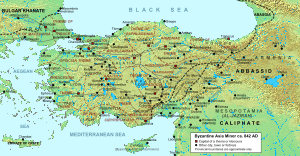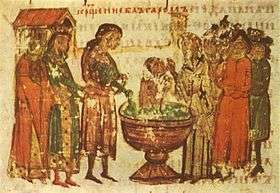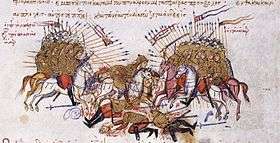Battle of Lalakaon
The Battle of Lalakaon (Greek: Μάχη τοῦ Λαλακάοντος), or Poson or Porson (Greek: Μάχη τοῦ Πό(ρ)σωνος),[1] was fought in 863 between the Byzantine Empire and an invading Arab army in Paphlagonia (modern northern Turkey). The Byzantine army was led by Petronas, the uncle of Emperor Michael III (r. 842–867), although Arab sources also mention the presence of Emperor Michael. The Arabs were led by the emir of Melitene (Malatya), Umar al-Aqta (r. 830s–863).
Umar al-Aqta overcame initial Byzantine resistance to his invasion and reached the Black Sea. The Byzantines then mobilized their forces, encircling the Arab army near the River Lalakaon. The subsequent battle, ending in a Byzantine victory and the emir's death on the field, was followed by a successful Byzantine counteroffensive across the border. The Byzantine victories were decisive; the main threats to the Byzantine borderlands were eliminated, and the era of Byzantine ascendancy in the East (culminating in the 10th-century conquests) began.
The Byzantine success had another corollary: deliverance from constant Arab pressure on the eastern frontier allowed the Byzantine government to concentrate on affairs in Europe, particularly in neighboring Bulgaria. The Bulgarians were pressured into accepting Byzantine Christianity, beginning their absorption into the Byzantine cultural sphere.
Background: Arab–Byzantine border wars
After the rapid Muslim conquests of the 7th century, the Byzantine Empire was confined to Asia Minor, the southern coasts of the Balkans, and parts of Italy. As Byzantium remained the caliphate's major infidel enemy, Arab raids into Asia Minor continued throughout the 8th and 9th centuries. These expeditions, launched from bases in the Arab frontier zone almost annually, eventually acquired a quasi-ritualistic character as part of the Muslim jihad (holy war).[2]
The Byzantines were generally on the defensive during the 7th–9th centuries,[3] and suffered some catastrophic defeats, such as the razing of Amorium (home city of the reigning Amorian dynasty) in 838.[4] With the waning of the Abbasid Caliphate's power after 842 and the rise of semi-independent emirates along the eastern Byzantine frontier, however, the Byzantines could increasingly assert themselves.[5]
During the 850s the most significant threats to the Byzantine Empire were the emirate of Melitene (Malatya), under Umar al-Aqta; the emirate of Tarsus, under Ali ibn Yahya ("Ali the Armenian"); the emirate of Qaliqala (Theodosiopolis, modern Erzurum), and the Paulicians of Tephrike, led by Karbeas.[6][7] Melitene, in particular, was a major threat to Byzantium; its location, on the western side of the Anti-Taurus range, allowed direct access to the Anatolian plateau. An indication of the threat posed by these lordships came in 860, when they combined to make an annus horribilis for the Byzantines. Umar and Karbeas raided deep into Asia Minor, returning with substantial plunder. This was followed shortly afterwards with another raid by the forces of Tarsus under Ali. Finally, a naval attack from Syria sacked Attaleia, capital of the naval Cibyrrhaeot Theme.[7][8]
Arab invasion of 863

Umar struck again during the summer of 863, joining forces with Abbasid general Ja'far ibn Dinar al-Khayyat (probably the governor of Tarsus) for a successful raid into Cappadocia. The Arabs crossed the Cilician Gates into Byzantine territory, plundering as they went, until they neared Tyana.[5][9][10] The Tarsian army returned home, but Umar obtained Ja'far's permission to press on into Asia Minor. Umar's forces were the greater part of his emirate's strength, but their size is unknown; the contemporary Muslim historian Ya'qubi writes that Umar had 8,000 men at his disposal, but the Byzantine historians Genesius and Theophanes Continuatus inflate the Arab army to 40,000 men. According to the Byzantinist John Haldon, the former number was closer to reality; Haldon estimates the combined Arab forces at 15,000–20,000 men.[9][11][12] It is likely that a Paulician contingent under Karbeas was also present, although this is not explicitly attested.[13][14]
Emperor Michael III assembled his army to counter the Arab raid, and met them in battle at an area known in Arab sources as Marj al-Usquf ("Bishop's Meadow"): a highland near Malakopeia, north of Nazianzus.[13][15] The battle was bloody, with heavy casualties on both sides; according to the Persian historian al-Tabari, only a thousand of Umar's army survived. Nevertheless, the Arabs escaped the Byzantines and continued their raid north into the Armeniac Theme, reaching the Black Sea and sacking the port city of Amisos. Byzantine historians report that Umar, enraged that the sea blocked his advance, ordered it to be lashed; modern scholars consider this account most likely inspired by a similar story about Xerxes during the Persian Wars.[15][16][17]
Battle
When Michael learned of the fall of Amisos, he ordered a huge force to be assembled—al-Tabari claims 50,000 men—under his uncle Petronas (the domestikos tōn scholōn) and Nasar, the stratēgos of the Bucellarian Theme. According to al-Tabari, the emperor commanded these forces in person, but this is not supported by Byzantine sources. Given the bias against Michael by historians writing during the subsequent Macedonian dynasty, the omission may be deliberate.[13][18][19] Byzantine armies, assembled from throughout the empire, converged on the Arabs from three directions: a northern army, made up of forces from the Black Sea themes of the Armeniacs, Bucellarians, Koloneia and Paphlagonia; a southern force (probably the one which fought at Bishop's Meadow and had since shadowed the Arab army), from the Anatolic, Opsician and Cappadocian themes and the kleisourai (frontier districts) of Seleukeia and Charsianon; and a western force under Petronas, with men from the Macedonian, Thracian and Thracesian themes and the imperial tagmata from the capital.[16][20][21]
Despite the difficulty of coordinating these widely separated forces, the Byzantine armies met on September 2 and surrounded Umar's smaller army at a location known as Poson (Πόσων) or Porson (Πόρσων) near the Lalakaon River.[14][22] The exact location of the river and the battle site have not been identified, but most scholars agree that they were near the Halys River, about 130 kilometres (81 mi) southeast of Amisos.[13][16] With the approach of the Byzantine armies, the only escape route open to the emir and his men was dominated by a strategically located hill. Both sides tried to occupy it during the night, but the Byzantines were victorious.[14][16][23] The following day, Umar threw his entire force towards the west (where Petronas was located) in an attempt at a breakthrough. The Byzantines stood firm, giving the other two Byzantine armies time to close in and attack the Arab army's exposed rear and flanks.[16][24][25] The rout was complete, with most of the Arab army (and Umar) falling in battle. Casualties may have included the Paulician leader Karbeas; although his participation in the battle is uncertain, it is recorded that he died that year.[22]
Only the emir's son, leading a small force, escaped the battlefield, fleeing south towards the border area of Charsianon. Pursued by Machairas, the kleisourarchēs of Charsianon, he was defeated and captured along with many of his men.[22][26]
Aftermath

The Byzantines moved quickly to take advantage of their victory; a Byzantine army invaded Arab-held Armenia and, sometime in October or November, defeated and killed Emir Ali ibn Yahya.[27][28] In a single campaigning season, the Byzantines had eliminated the three most dangerous opponents on their eastern border.[29] The successes were decisive, permanently destroying the power of Melitene. The Byzantine victory at Lalakaon altered the strategic balance in the region and marked the beginning of Byzantium's century-long offensive in the East.[3][28]
The importance of these victories did not go unnoticed at the time. The Byzantines hailed them as revenge for the sack of Amorium 25 years earlier, the victorious generals were granted a triumphal entry into Constantinople, and special celebrations and services were held.[1][27] Petronas received the exalted court title of magistros, and the kleisoura of Charsianon was raised to the status of a full theme.[27][29] Al-Tabari reports that the news of the deaths of Umar and Ali—"strong defenders of Islam, men of great courage who elicited enormous praise among the frontier districts where they served"—provoked an outpouring of grief in Baghdad and other cities, culminating in riots and looting. Although private donations and volunteers for the holy war began to gather at the border, "the central authorities [were not] prepared to send a military force against the Byzantines on their own account in those days" because of ongoing internal turmoil in the Abbasid Caliphate.[30]
The removal of the eastern threat and increasing Byzantine confidence also opened up opportunities in the west, where the Bulgarian ruler Boris (r. 852–889) had been negotiating with the Pope and Louis the German (r. 817–876) for the conversion of himself and his people to Christianity. This expansion of Rome's ecclesiastic influence to Constantinople's doorstep could not be tolerated by the Byzantine government. The victorious eastern armies were transferred to Europe and invaded Bulgaria in 864, a demonstration of military might which convinced its ruler to accept Byzantine missionaries instead. Boris was baptized—taking the name Michael in honor of the Byzantine emperor—beginning the Christianization of Bulgaria and his nation's absorption into the Byzantine-influenced Eastern Orthodox world.[1][29][31]
Influence on heroic poetry
According to the French Byzantinist Henri Grégoire, the Byzantine success against the Arabs which culminated in the Battle of Lalakaon inspired one of the oldest surviving acritic (heroic) poems: the Song of Armouris. According to Grégoire, the eponymous protagonist (the young Byzantine warrior Armouris) was inspired by Emperor Michael III.[32] A battle in the Byzantine epic cycle around Digenis Akritas is also reminiscent of the events at Lalakaon, as the eponymous hero surrounds an Arab army near Malakopeia.[33][34] Strong influences can be found in episodes of the Arab, and later Turkish, epics about Battal Ghazi and in an episode in One Thousand and One Nights.[35]
References
- 1 2 3 Jenkins 1987, p. 163.
- ↑ El-Cheikh 2004, pp. 83–84.
- 1 2 El-Cheikh 2004, p. 162.
- ↑ Treadgold 1997, p. 441.
- 1 2 Haldon 2001, p. 83.
- ↑ Treadgold 1997, p. 451.
- 1 2 Whittow 1996, p. 310.
- ↑ Vasiliev 1935, pp. 240–246.
- 1 2 Huxley 1975, p. 448.
- ↑ Vasiliev 1935, p. 249.
- ↑ Haldon 2001, pp. 83–84.
- ↑ Vasiliev 1935, pp. 249–250.
- 1 2 3 4 Kiapidou 2003, Chapter 1 Archived February 20, 2012, at the Wayback Machine..
- 1 2 3 Jenkins 1987, p. 162.
- 1 2 Huxley 1975, pp. 448–449.
- 1 2 3 4 5 Haldon 2001, p. 84.
- ↑ Vasiliev 1935, pp. 250–251.
- ↑ Huxley 1975, pp. 443–445, 449.
- ↑ Vasiliev 1935, pp. 251–252.
- ↑ Huxley 1975, p. 445.
- ↑ Vasiliev 1935, p. 253.
- 1 2 3 Kiapidou 2003, Chapter 2 Archived February 20, 2012, at the Wayback Machine..
- ↑ Vasiliev 1935, p. 254.
- ↑ Jenkins 1987, pp. 162–163.
- ↑ Vasiliev 1935, pp. 254–255.
- ↑ Vasiliev 1935, pp. 255–256.
- 1 2 3 Kiapidou 2003, Chapter 3 Archived February 20, 2012, at the Wayback Machine..
- 1 2 Whittow 1996, p. 311.
- 1 2 3 Treadgold 1997, p. 452.
- ↑ Saliba 1985, pp. 10–12.
- ↑ Whittow 1996, pp. 282–284.
- ↑ Beck 1971, p. 54.
- ↑ Vasiliev 1935, pp. 225–226 (note #2).
- ↑ Huxley 1975, pp. 447–448.
- ↑ Vasiliev 1935, p. 21.
Sources
- Beck, Hans Georg (1971). Geschichte der byzantinischen Volksliteratur (in German). Munich: Verlag C. H. Beck. ISBN 3-406-01420-8.
- El-Cheikh, Nadia Maria (2004). Byzantium Viewed by the Arabs. Cambridge, Massachusetts: Harvard Center for Middle Eastern Studies. ISBN 0-932885-30-6.
- Haldon, John (2001). The Byzantine Wars: Battles and Campaigns of the Byzantine Era. Stroud, Gloucestershire: Tempus. ISBN 0-7524-1795-9.
- Huxley, George L. (1975). "The Emperor Michael III and the Battle of Bishop's Meadow (A.D. 863)" (PDF). Greek, Roman, and Byzantine Studies. Durham, North Carolina: Duke University (16): 443–450. ISSN 0017-3916. Archived from the original (PDF) on February 6, 2007.
- Jenkins, Romilly (1987). Byzantium: The Imperial Centuries, AD 610–1071. Toronto: University of Toronto Press. ISBN 0-8020-6667-4.
- Kiapidou, Eirini-Sofia (17 January 2003). "Battle of Lalakaon River, 863". Encyclopedia of the Hellenic World, Asia Minor. Athens: Foundation of the Hellenic World. Archived from the original on 2011-07-21.
- Saliba, George, ed. (1985). The History of al-Ṭabarī, Volume 35: The Crisis of the ʿAbbāsid Caliphate: The Caliphates of al-Mustaʿīn and al-Muʿtazz, A.D. 862–869/A.H. 248–255. SUNY series in Near Eastern studies. Albany, New York: State University of New York Press. ISBN 978-0-87395-883-7.
- Treadgold, Warren (1997). A History of the Byzantine State and Society. Stanford, California: Stanford University Press. ISBN 0-8047-2630-2.
- Vasiliev, A. A. (1935). Byzance et les Arabes, Tome I: La Dynastie d'Amorium (820–867) (in French). French ed.: Henri Grégoire, Marius Canard. Brussels: Éditions de l'Institut de Philologie et d'Histoire Orientales. OCLC 493044898.
- Whittow, Mark (1996). The Making of Byzantium, 600–1025. Berkeley and Los Angeles, California: University of California Press. ISBN 0-520-20496-4.
